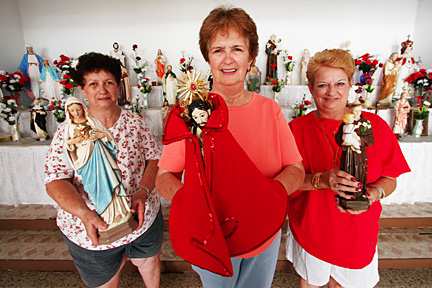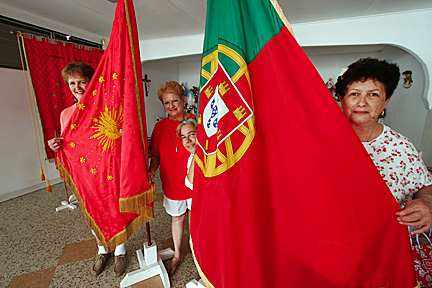
|
View from
the Pew |
Tradition
on the move
A Portuguese Holy Ghost festival
will be held in Kakaako for the
final time in a 90-year run
Descendants of Hawaii's earliest Portuguese immigrants will mark a religious tradition and celebrate their ethnic heritage tomorrow, turning a block of the urban commercial zone of Kakaako into the village it once was -- just for a few hours.Statues of Jesus, Mary, Joseph and a company of assorted saints will be marched out in the Kewalo Holy Ghost Society's annual procession along busy Kapiolani Boulevard, Ward Avenue and Queen Street.
The day's festivities will begin with 9:30 a.m. Mass at the society's social hall at 815 Queen St. The parade will end there, and the party continues with a free lunch, an auction and an afternoon of "talk story" time for people who return to the scene each year to recall the days when their parents, grandparents and great-grandparents enjoyed the same traditions.
The Holy Ghost festival is a uniquely Portuguese observance of Pentecost, which was marked last month in Catholic and Protestant churches. Several other Holy Ghost associations in the state also stage celebrations, which have their roots in a story of faith and miracles from the 14th century.
It's the 90th year for the Kewalo celebration. It is also likely to be the last time at the old location.
Dolores Pinao said the 19,000-square-foot Queen Street property will be sold. What used to be a center of social life for the people whose houses surrounded it is now rarely used. Hot and noisy, the small chapel and open-air social hall are crammed in among auto repair shops and hostess bars. A Queen Street widening project will take away the few remaining parking spaces.
"It's just not the same," said Pinao, chairwoman of the festival.
"I just hope we will find another place," added Jacqueline Moniz.
"We can't let the traditions die; we owe it to our families," said Patricia Medeiros.

The Kewalo Holy Ghost Society will stage its 90th Holy Ghost festival tomorrow at its Queen Street location. Patricia Medeiros, left, holding the Sacred Heart of Mary statue, Jacqueline Moniz, holding the St. Christo statue, and Dolores Pinao, holding a statue of St. Anthony with the baby Jesus, will be holding the statues during tomorrow's procession.
"We lived across the street; my father worked at the newspaper," said Moniz. She and Medeiros are among the 13 children of Antone and Mary Medeiros. "We paid $59 for rent. I know because I had to take it to the Magoon laundry."
"We lived on Kawaiahao," said Pinao. "My mother owned seven little houses."
"The Pachecos lived there. He made sausage," said Medeiros. "The DeMellos lived there ... and the Andrades, the Perreiras, the Correas ..."
"Our parents would go into the church; we ran around outside," they remembered.
It was in the 1950s that the small concrete-block chapel was last regularly used for Masses, Moniz said. It was built after World War II; a remnant of the wall of the original 1915 chapel can be seen in the basement kitchen.
The chapel houses more than 30 small statues, some nearly 100 years old, donated by members and which line shelves built for them. The three women have cleansed the images with white wine and washed lace and brocade garments that decorate some statues.
That's what their mothers did before them.
There's an order of march for tomorrow's procession that was also established by the older generations. They call it the "seven dominga," which translates as the seven Sundays. It is observed elsewhere as the seven weeks between Easter and Pentecost, which in the Bible is the day the Holy Spirit descended upon the apostles in the form of tongues of fire.
Families in the Kewalo Holy Ghost Society bid for the honor of taking charge of each dominga each Sunday devotion.
Those who pull the winning numbers also get designated places in the procession. The winner of the "first dominga" carries the statue of the Blessed Virgin Mary, second comes Baby Jesus, and so on, through the "seventh dominga," a crown.
Tricia Pitt, 15, of Kailua -- her mother was a Correa -- will wear the crown tomorrow as queen of the procession.

Jacqueline Moniz, left, and Dolores Pinao stand behind the "permasa," a banner depicting the Holy Spirit as a dove, while Angela Medeiros and Patricia Medeiros stand behind the Portuguese flag. Both flags will be carried during tomorrow's procession.
Alas, there's no written record of the history of the festival. And no one in the younger generations speaks Portuguese. So there are some aspects of the Holy Ghost celebration that are not understood by modern celebrants.
The banner depicting the Holy Spirit as a dove is called the "permasa." That translates as "promise" and apparently indicates that a petitioner has made a vow to fulfill some devotional or charitable obligation. No one can explain why it has become the honor of the society president to carry it.
And then there's "Santo Cristo." It translates as "Holy Christ" and is a favorite name of churches wherever Portuguese people have settled. Portuguese travel Web sites describe a festival in the Azores named for Christ of Miracles, "Senhor Santo Cristo dos Milagres."
But the Santo Cristo statue that is designated for fifth place in the procession tomorrow is of a bearded, caped man. The story goes, said Medeiros, that the saint was found in the forest, missing both legs, and was the source of miracles.
Pinao has heard from three University of Hawaii students from Portugal, excited to learn of the festival, who plan to attend. Perhaps some help is on the way to translate traditions dimmed by time.
One thing that old-timers won't need a translation for is the lunch menu tomorrow.
Society President Bernard Correa, a fourth-generation Portuguese, and Stacy Balanay, both chefs, have prepared a meal featuring vinha d'alhos, garlicky marinated roast beef that was a signature dish of Portuguese housewives. It is a treat only rarely found on a restaurant menu or on the table in a Portuguese home.
It's a memory of the old Kakaako village days that will be relived with gusto tomorrow.
![]()
E-mail to Features Desk
[News] [Business] [Features] [Sports] [Editorial] [Do It Electric!]
[Classified Ads] [Search] [Subscribe] [Info] [Letter to Editor]
[Feedback]
